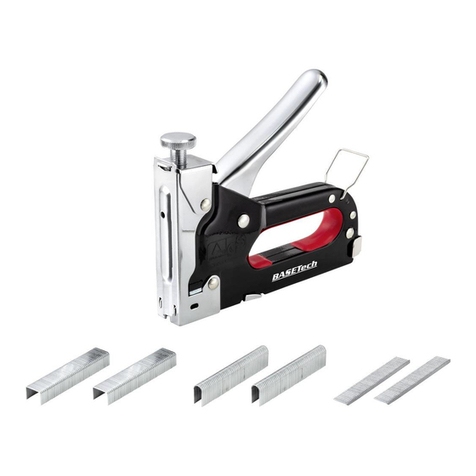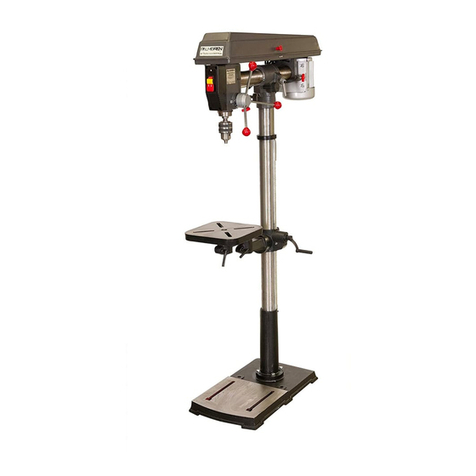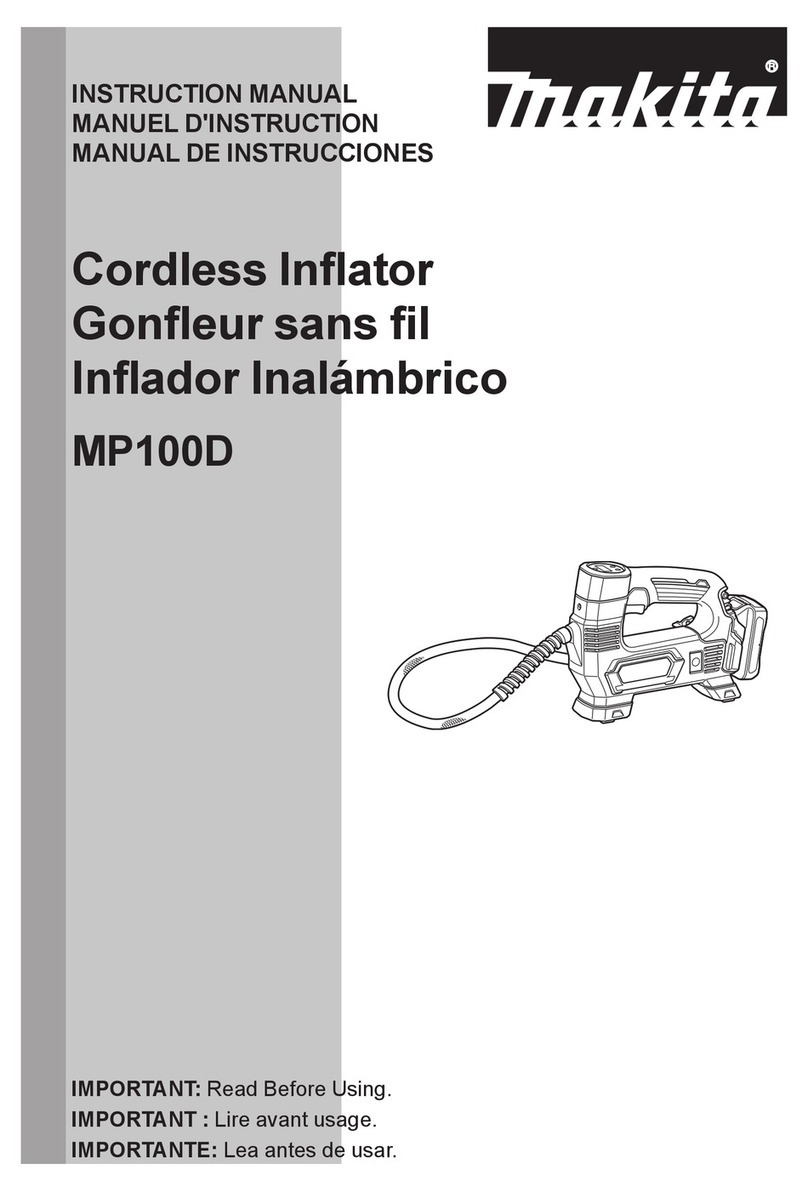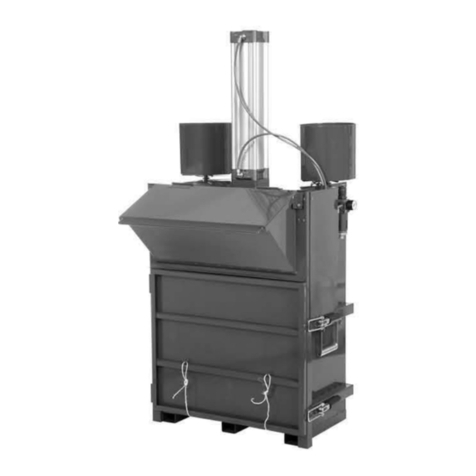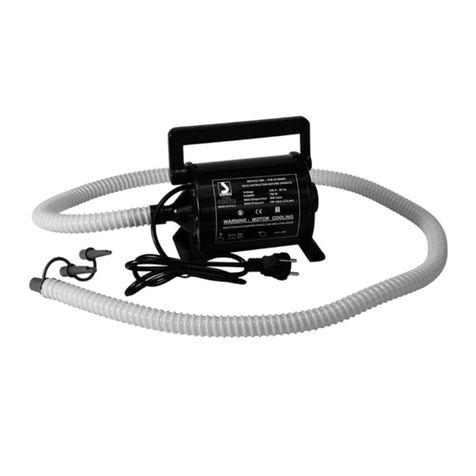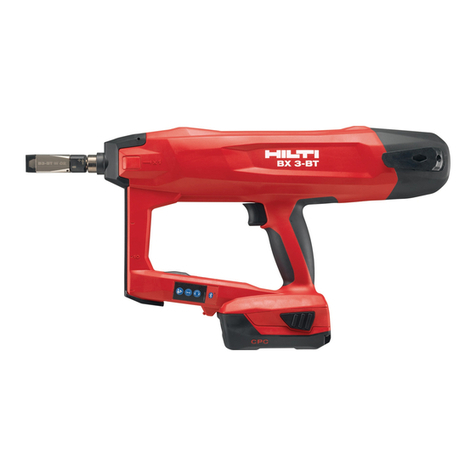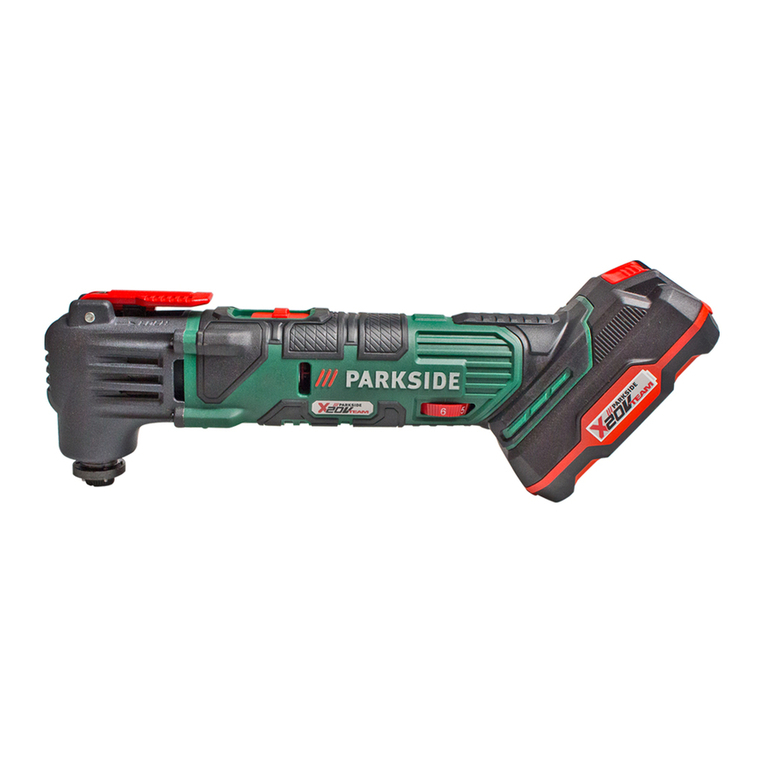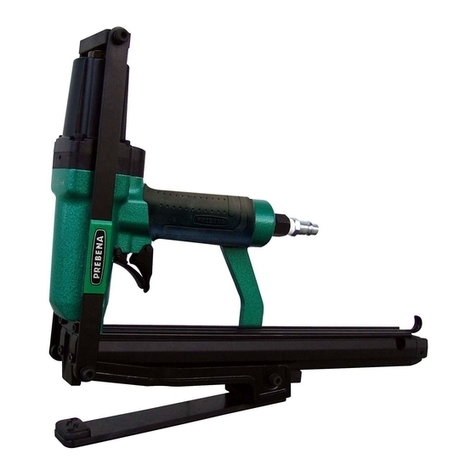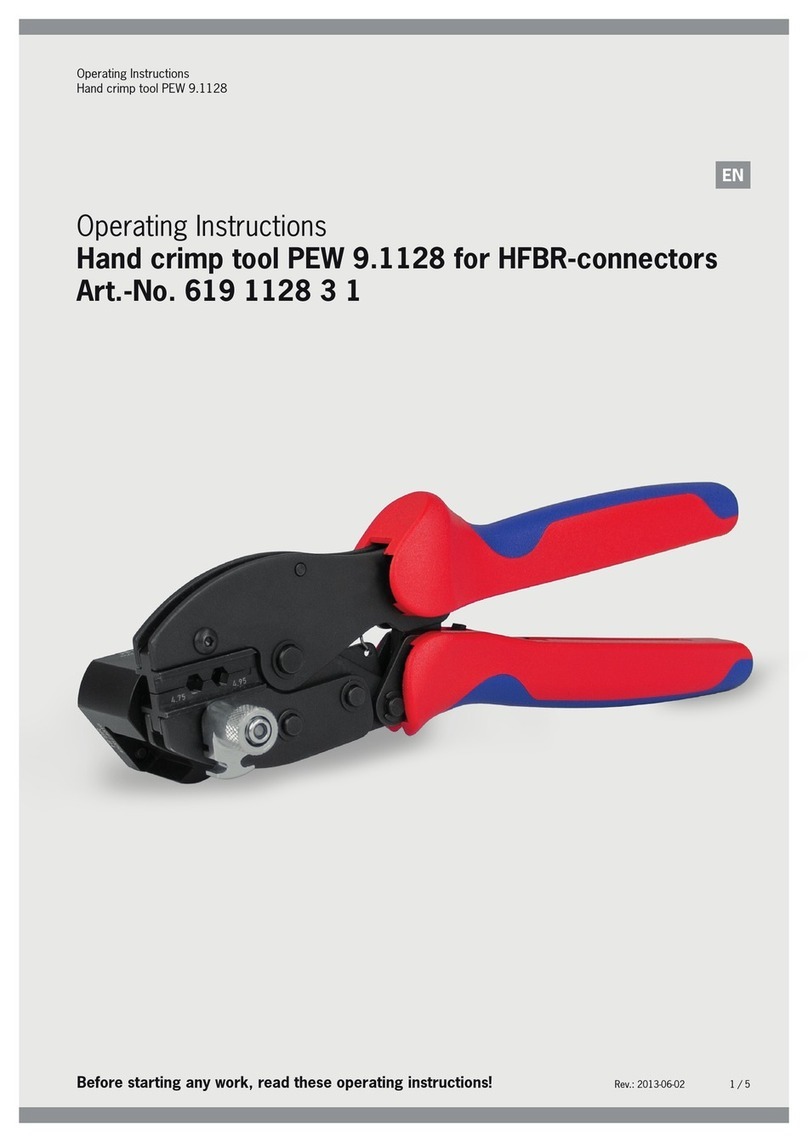Toolshop 241-9778 User manual

1.2 A ROTARY TOOL
241-9778
Owner’s Manual
PRODUCT SPECIFICATIONS
Rating:
120 V, 60 Hz AC
Amperes:
1.2 A
RPM:
10,000–35,000 RPM (no load)
Collets:
3/32" & 1/8"
Weight:
1 lb 8 oz (0.67 kg)
Need Assistance?
Call us on our toll free customer support line:
1-866-349-8665
Technical questions
Replacement parts
Parts missing from package
Distributed by: Menard, Inc., Eau Claire, WI 54703

2
Product specifications ………….…………………………………………………….
1
Table of contents ……………………………………………………………………...
2
General safety warnings ……………………………………………………………..
3–4
Eye, ear & lung protection ……………………………………………………………
3–4
Electrical safety ……………………………………………………………………….
4
Power tool safety ……………………………………………………………………...
5–6
General safety warning ………………………………………………………………
5
Work area safety ………………………………………………………………….…..
5
Electrical safety ……………………………………………………………………….
5
Personal safety ………………………………………………………………………..
5–6
Power tools use and care.……………………………………………………………
6
Service …………………………………………………………………………………
6
Specific safety rules …………………………………………………………………..
7
Extension cord safety ………………………………………………………………...
8
Symbols ………………………………………………………………………………..
9
Know your rotary tool …………………………………………………………………
10
Accessories ……………………………………………………………………………
10
Contents ……………………………………………………………………………….
11
Accessory case contents …………………………………………………………….
12–13
Accessory description & use ………………………………………………………...
13–14
Assembly and operating ……………………………………………………………..
15–17
Speed selection ……………………………………………………………………….
15
ON/OFF switch ………………………………………………………………………..
15
Changing the collet …………………………………………………………………...
15–16
Installing accessories …………………………………………………………………
16
Selecting proper speeds ……………………………………………………………..
17
Maintenance …………………………………………………………………………..
17
Exploded view …………………………………………………………………………
18
Parts list ………………………………………………………………………………..
19
Warranty ……………………………………………………………………….………
20
TABLE OF CONTENTS

3
EYE, EAR & LUNG PROTECTION
This instruction manual includes the following:
General Safety Rules
Specific Safety Rules and Symbols
Functional Description
Assembly
Operation
Maintenance
Accessories
!
ALWAYS WEAR EYE PROTECTION THAT CONFORMS WITH CSA
REQUIREMENTS or ANSI SAFETY STANDARD Z87.1
FLYING DEBRIS can cause permanent eye damage. Prescription
eyeglasses ARE NOT a replacement for proper eye protection.
WARNING: Non-compliant eyewear can cause serious injury if
broken during the operation of a power tool.
SAVE THESE INSTRUCTIONS FOR REFERENCE
WARNING: Use hearing protection, particularly during extended
periods of operation of the tool, or if the operation is noisy.
!
GENERAL SAFETY WARNINGS
WARNING: Before using this tool or any of its accessories, read this
manual and follow all Safety Rules and Operating Instructions. The important
precautions, safeguards and instructions appearing in this manual are not
meant to cover all possible situations. It must be understood that common
sense and caution are factors which cannot be built into the product.
!

4
ELECTRICAL SAFETY
WARNING: To avoid electrical hazards, fire hazards or damage to the
tool, use proper circuit protection.
This tool is wired at the factory for 120 V AC operation. It must be
connected to a 120 V AC, 15 A circuit that is protected by a time-delayed
fuse or circuit breaker. To avoid shock or fire, replace power cord
immediately if it is worn, cut or damaged in any way.
GENERAL SAFETY WARNINGS
WEAR A DUST MASK THAT IS DESIGNED TO BE USED WHEN
OPERATING A POWER TOOL IN A DUSTY ENVIRONMENT.
WARNING: Dust that is created by power sanding, sawing, grinding,
drilling, and other construction activities may contain chemicals that are
known to cause cancer, birth defects, or other genetic abnormalities. These
chemicals include:
Lead from lead-based paints
Crystalline silica from bricks, cement, and other masonry products
Arsenic and chromium from chemically treated lumber
The level of risk from exposure to these chemicals varies, according to how
often this type of work is performed. In order to reduce exposure to these
chemicals, work in a well-ventilated area, and use approved safety
equipment, such as a dust mask that is specifically designed to filter out
microscopic particles.
!

5
WARNING: Read all safety warnings
and instructions. Failure to follow the
warnings and instructions may result in
electric shock, fire and/or serious injury.
Save all warnings and instructions for
future reference.
Work area safety
Keep work area clean and well lit.
Cluttered or dark areas invite accidents.
Do not operate power tools in explosive
atmospheres, such as in the presence
of flammable liquids, gases or dust.
Power tools create sparks which may
ignite the dust or fumes.
Keep children and bystanders away
while operating a power tool.
Distractions can cause you to lose control.
Electrical safety
Power tool plugs must match the outlet.
Never modify the plug in any way. Do
not use any adapter plugs with earthed
(grounded) power tools. Unmodified
plugs and matching outlets will reduce risk
of electric shock.
Avoid body contact with earthed or
grounded surfaces such as pipes,
radiators, ranges and refrigerators.
There is an increased risk of electric shock
if your body is earthed or grounded.
Do not expose power tools to rain or
wet conditions. Water entering a power
tool will increase the risk of electric shock.
Do not abuse the cord. Never use the
cord for carrying, pulling or unplugging
the power tool. Keep cord away from
heat, oil, sharp edges or moving parts.
Damaged or entangled cords increase the
risk of electric shock.
When operating a power tool outdoors,
use an extension cord suitable for
outdoor use. Use of a cord suitable for
outdoor use reduces the risk of electric
shock.
If operating a power tool in a damp
location is unavoidable, use a residual
current device (RCD) protected supply.
Use of a ground fault circuit interrupter
(GFCI) reduces the risk of electric shock.
Personal safety
Stay alert, watch what you are doing
and use common sense when operating
a power tool. Do not use a power tool
while you are tired or under the
influence of drugs, alcohol or
medication. A moment of inattention while
operating power tools may result in serious
personal injury.
Use personal protective equipment.
Always wear eye protection. Protective
equipment such as dust mask, non-skid
safety shoes, hard hat, or hearing
protection used for appropriate conditions
will reduce personal injuries.
Prevent unintentional starting. Ensure
the switch is in the off-position before
connecting to power source and/or
battery pack, picking up or carrying the
tool. Carrying power tools with your finger
on the switch or energising power tools
that have the switch on invites accidents.
POWER TOOL SAFETY
!

6
PERSONAL SAFETY –cont’d
Remove any adjusting key or wrench
before turning the power tool on. A
wrench or a key left attached to a rotating
part of the power tool may result in
personal injury.
Do not overreach. Keep proper footing
and balance at all times. This enables
better control of the power tool in
unexpected situations.
Dress properly. Do not wear loose
clothing or jewellery. Keep your hair,
clothing and gloves away from moving
parts. Loose clothes, jewellery or long hair
can be caught in moving parts.
If devices are provided for the
connection of dust extraction and
collection facilities, ensure these are
connected and properly used. Use of
dust collection can reduce dust-related
hazards.
Power tool use and care
Do not force the power tool. Use the
correct power tool for your application.
The correct power tool will do the job
better and safer at the rate for which it was
designed.
Do not use the power tool if the switch
does not turn it on and off. Any power
tool that cannot be controlled with the
switch is dangerous and must be repaired.
Disconnect the plug from the power
source and/or the battery pack from the
power tool before making any
adjustments, changing accessories, or
storing power tools. Such preventive
safety measures reduce the risk of starting
the power tool accidentally.
Store idle power tools out of the reach
of children and do not allow persons
unfamiliar with the power tool or these
instructions to operate the power tool.
Power tools are dangerous in the hands of
untrained users.
Maintain power tools. Check for
misalignment or binding of moving
parts, breakage of parts and any other
condition that may affect the power
tool’s operation. If damaged, have the
power tool repaired before use. Many
accidents are caused by poorly maintained
power tools.
Keep cutting tools sharp and clean.
Properly maintained cutting tools with
sharp cutting edges are less likely to bind
and are easier to control.
Use the power tool, accessories and
tool bits etc. in accordance with these
instructions, taking into account the
working conditions and the work to be
performed. Use of the power tool for
operations different from those intended
could result in a hazardous situation.
Hold power tools by insulated gripping
surfaces when performing an operation
where the cutting tool may contact
hidden wiring or its own cord. Contact
with a "live" wire will make exposed metal
parts of the tool "live" and shock the
operator.
Service
Have your power tool serviced by a
qualified repair person using only
identical replacement parts. This will
ensure that the safety of the power tool is
maintained.
POWER TOOL SAFETY

7
WARNING: Know your rotary tool.
Do not plug the tool into the power
source until you have read and
understand this Instruction Manual.
Learn the tool’s applications and
limitations, as well as the specific
potential hazards related to this tool.
Following this rule will reduce the risk of
electric shock, fire, or serious injury.
Always wear eye protection.
Any power tool can throw
foreign objects into your eyes
and cause permanent eye
damage. ALWAYS wear safety goggles
(not glasses) that comply with ANSI safety
standard Z87.1. Everyday glasses have
only impact resistant lenses. They ARE
NOT safety glasses.
WARNING: Glasses or goggles
not in compliance with ANSI Z87.1
could cause serious injury when they
break.
Hold tool by insulated gripping surfaces
when performing an operation where
the cutting tool may contact hidden
wiring or its own cord. Contact with a
“live” wire will make exposed metal parts of
the tool “live” and shock the operator.
Always make sure the work surface is
free from nails and other foreign
objects. Cutting into a nail can cause the
bit and the tool to jump and damage the
bit.
Never hold the workpiece in one hand
and the tool in the other hand when in
use. Never place the hands near or
below the cutting surface. Clamping the
material and guiding the tool with both
hands is much safer.
Never lay workpiece on hard surfaces
like concrete, stone, etc. Protruding
cutting bit may cause the tool to jump.
Always wear safety goggles and dust
mask. Use only in well-ventilated area.
Using personal safety devices and working
in a safe environment reduces risk of
injury.
After changing the bits and accessories
or making adjustments, make sure the
collet nut and any other adjustment
devices are securely tightened. Loose
adjustment devices will be violently thrown.
Always use the correct collet size. If the
collet size is larger than the accessory
shank size it will not grip the shank
properly, leading to possible injury to the
operator or damage to the tool.
Always check accessory bits, grinding
stones, cut-off wheels etc. for damage
before each use. Damaged accessories
can break during use and cause serious
injury.
Never use dull or damaged bits. Sharp
bits must be handled with care.
Damaged bits can snap during use. Dull
bits require more force to push the tool,
possibly causing the bit to break.
Never touch the bit during or
immediately after use. After use the bit is
too hot to be touched by bare hands.
SPECIFIC SAFETY RULES
!
SAVE THESE INSTRUCTIONS FOR REFERENCE
!

8
WARNING: Keep the extension
cord clear of the working area. Position
the cord so it will not get caught on the
workpiece, tools or any other
obstructions while you are working with
the power tool.
Make sure any extension cord used
with this tool is in good condition. When
using an extension cord, be sure to use
one of heavy enough gauge to carry the
current the tool will draw. An undersized
cord will cause a drop in line voltage
resulting in loss of power and overheating.
The table at right shows the correct size to
use according to cord length and
nameplate ampere rating. If in doubt, use
the next heavier gauge. The smaller the
gauge number the heavier the cord.
Be sure your extension cord is properly
wired and in good condition. Always
replace a damaged extension cord or have
it repaired by a qualified electrician before
using it. Protect your extension cord from
sharp objects, excessive heat and damp or
wet areas.
Use a separate electrical circuit for your
power tools. This circuit must not be less
than 14 gauge wire and should be
protected with either a 15 A time delayed
fuse or circuit breaker. Before connecting
the power tool to the power source, make
sure the switch is in the OFF position and
the power source is the same as indicated
on the nameplate. Running at lower
voltage will damage the motor.
EXTENSION CORD SAFETY
MINIMUM GAUGE (AWG)
EXTENSION CORDS (120 V use only)
Amperage
rating
Total length
More
than
Not
more
than
25'
(7.5 m)
50'
(15 m)
100'
(30 m)
150'
(45 m)
0
6
18
16
16
14
6
10
18
16
14
12
10
12
16
16
14
12
12
16
14
12
Not Applicable
!

9
V
Volts
A
Amperes
Hz
Hertz
W
Watts
kW
Kilowatts
Microfarads
L
Litres
kg
Kilograms
H
Hours
N/cm2
Newtons per square
centimetre
Pa
Pascals
Min
Minutes
S
Seconds
or a.c.
Alternating current
Three-phase alternating
current
Three-phase alternating
current with neutral
Direct current
No load speed
Alternating or direct
current
Class II construction
Splash-proof
construction
Watertight construction
Protective grounding at
grounding terminal,
Class I tools
Revolutions or
reciprocations per
minute
Diameter
Off position
Arrow
Warning symbol
Wear your safety
glasses
SYMBOLS
WARNING: Some of the following symbols may appear on the rotary
tool. Study these symbols and learn their meaning. Proper interpretation of
these symbols will allow for more efficient and safer operation of this tool.
!
This symbol designates that this tool is
listed with U.S. requirements by
Underwriters Laboratories.
Conforms to UL Std. 60745-1, 60745-2-3.
61TN
E213739
SIJ-135U

10
AVAILABLE ACCESSORIES
WARNING: Use only accessories
that are recommended for this rotary
tool. Follow the instructions that
accompany the accessories. The use of
improper accessories may result in
injury to the operator or damage to the
tool.
Before using any accessory, carefully read
the instructions or the owner’s manual for
the accessory.
NOTE: Most commonly used bits and
accessories with 3/32” and 1/8” shanks will
fit this tool.
Grinding stones
Cut-off wheels
Polishing wheels
Wire brushes
Bristle brushes
Sanding drums
Cutting bits
Drill bits
Dressing stones
WARNING: If any part is missing or
damaged, do not plug the tool into the
power source or install any accessory until
the missing or damaged part is replaced.
KNOW YOUR ROTARY TOOL
ACCESSORIES
!
!
Air vents
Speed control
wheel
Hanging loop
Spindle lock
button
Collet nut
Umbrella
nut
ON/OFF switch
Motor
brushes

11
CONTENTS
Carefully unpack the rotary tool. Compare
the contents against the “ROTARY TOOL
COMPONENTS” chart below.
NOTE: See illustration of the rotary tool on
Pages 12 & 13.
WARNING: To avoid fire or toxic
reaction, never use gasoline, naphtha,
acetone, lacquer thinner or similar
highly volatile solvents to clean the
tool.
CONTENTS
ROTARY TOOL COMPONENTS
KEY
DESCRIPTION
QTY
A
Rotary tool
1
B
General purpose
accessory kit (see
Pages 12 & 13 for
contents)
1
Owner’s Manual
1
!

12
ACCESSORY CASE CONTENTS
Illustration
Description
Shape
Qty
Sanding disc
Round
3
Abrasive buff
Round
1
Grinding stone
Round
1
Screw mandrel
Cylindrical with
screw
1
Steel brush
Radial
1
Bristle brush
Radial
1
Steel brush
Axial
1
Bristle brush
Axial
1
Drum sander
With sanding
band –small
1
Drum sander
With sanding
band –large
1
Aluminum oxide
grinding stone
Cylinder –small
1
Aluminum oxide
grinding stone
Cylinder - large
1
Aluminum oxide
grinding stone
Spherical
1
Aluminum oxide
grinding stone
Radial
1
Aluminum oxide
grinding stone
Conical
1
Aluminum oxide
grinding stone
Round bottom
1
Collet
1/8" (3.2 mm)
(packed in tool)
1
Collet
3/32" (2.4 mm)
1

13
ACCESSORY CASE CONTENTS
Illustration
Description
Shape
Qty
Diamond wheel
point
Spherical
1
Diamond wheel
point
Cylindrical –small
1
Diamond wheel
point
Cylindrical - large
1
Collet wrench
1
ACCESSORY DESCRIPTION & USE
There are many different types of accessories that can be used with this rotary tool.
The following charts identify the most popular accessories and their uses.
NOTE: Please see the accessory case contents on Pages 12 & 13 to identify the
accessories that are included with this rotary tool.
Accessory Description
Accessory Use
Aluminum oxide
Grinding stones
Grinding wheels
Abrasive wheels
Use on metals, castings, welded joints, rivets and
rust. Ideal for sharpening, de-burring, rust removal
and general-purpose grinding of most materials.
Cut-off wheel
Ideal for cutting, grooving and trimming all kinds of
materials—including metal, wood and ceramics.
You can use it to cut screws and rusted bolts,
make slots in screw heads, trim castings and more.
Polishing wheel
Felt & cloth
Ideal for polishing most metal surfaces and
plastics. Can be used with polishing compound.
Bristle brush
Use for light de-burring, cleaning and polishing of
silverware, jewellery and other precious metals.
Can be used with polishing compound.
Sanding band
For rough shaping and smoothing wood and
fibreglass; removing rust from metal surfaces;
shaping rubber surfaces. Sanding bands are easily
replaceable on drums.
Sanding wheel
Ideal for rough-shaping and smoothing wood and
fibreglass—as well as removing rust from metal
surfaces, shaping rubber surfaces and more.

14
ACCESSORY DESCRIPTION & USE
Accessory Description
Accessory Use
Screw mandrel
Use with sanding discs, felt wheels, polishing,
grinding and cut-off wheels.
Mandrel for cloth wheel
Use with sanding discs and polishing, grinding and
cut-off wheels.
Collet
For use with accessories.
Collet wrench
For tightening & loosening collet nut, screw of drum
sanders
Dressing stone
Cleans grinding wheels and stones. Shapes or
reshapes stones for desired applications.
Silicon carbide
Stones
Wheels
Designed to work well on stone, glass, ceramics,
porcelain and non-ferrous metals.
Polishing wheel
Emery-impregnated
Ideal for cleaning and polishing coarse surfaces.
Stainless steel brush
Stainless steel brushes do not cause "after-rust"
when used on corrosive-resistant materials like
pewter, aluminum and stainless steel.
Brass brush
Brass brushes are non-sparking and softer than
steel. They will not scratch soft metals like gold,
copper, brass, etc.
High-speed steel cutter
For shaping, hollowing, grooving, slotting and
making tapered holes in soft metals, plastics and
woods.
Multi-purpose bit
Cuts wood, plastic, fibreglass, drywall, laminate
and aluminum and vinyl siding.
Mandrel for emery-impregnated
polishing wheel
Use with emery-impregnated polishing wheel.
Carbide grout cutter
Ideal for use on wall and floor grout
Flap wheel
Flap wheels grind and polish flat or contoured
surfaces. They are used most effectively to finish a
surface after heavier sanding and material removal
have been completed.
Diamond wheel point
Great for cutting, sawing and carving of hard
materials such as marble, concrete, brick,
porcelain, ceramics, hard epoxy and soft and hard
wood.
Engraving Cutter
For detail engraving, carving and routing in wood,
fibreglass, plastic and soft metals
Tungsten-carbide cutter
Use for shaping, smoothing and material removal.
Use on hardened steel, stainless steel, cast iron,
nonferrous metals, fired ceramics, plastics, hard
woods and other hard materials.
NOTE: This TOOL SHOP®Rotary Tool is compatible with most accessories and
attachments provided by other leading brands.

15
SPEED SELECTION
Set the rotary tool speed by rotating the
variable speed control dial (1) to the
appropriate speed (Fig. 1). Position the
speed control dial at “1” for slowest speed,
“3” for medium speed and at “MAX” for the
highest speed.
ON/OFF SWITCH
To turn the switch ON, push on the lower
part of the ON/OFF switch (1) (Fig. 2). To
turn the switch OFF, push on the upper
part of the ON/OFF switch (2).
CHANGING THE COLLET
Some accessories require the use of
different sized collets. Collet sizes can be
1/16", 3/32" and 1/8". It is important to ensure
that the collet size matches the accessory.
NOTE: This tool includes the most
commonly used collets: 3/32" and1/8".
WARNING: Using a collet that is
too large for the accessory will result in
the accessory possibly being thrown
from the tool causing serious injury.
1. Turn the tool switch OFF and remove
the plug from the power source.
2. Depress the spindle lock button (1)
and slowly turn the collet nut (2) until
the spindle lock button locks the
spindle (3) (Fig. 3).
3. While holding the spindle lock button
down, turn the collet nut counter
clockwise until it is removed.
4. Remove the collet (4) by pulling it out
of the spindle.
ASSEMBLY AND OPERATING
!
Fig. 3
Fig. 2
Fig. 1

16
CHANGING THE COLLET –cont’d
5. Insert the replacement collet into the
spindle and replace the collet nut by
turning it clockwise while holding the
spindle lock button down.
NOTE: Do not tighten the collet nut without
an accessory installed in the collet. You
will damage the collet.
INSTALLING ACCESSORIES
1. Turn the switch OFF and disconnect
the tool from the power source.
2. Depress the spindle lock button (1)
and slowly turn the collet nut (2) until
the spindle lock button locks the
spindle (Fig. 4).
3. While holding the spindle lock button
down, turn the collet nut counter-
clockwise until the collet is loose
inside the collet nut.
4. Insert accessory (3) into collet.
NOTES:
a) Make sure the correct collet is used for
the accessory. If collet is too large, replace
the collet with the next smaller size.
b) Insert accessory at least 3/4" into the
collet.
5. Press the spindle lock button and
engage it in the spindle. While holding
the spindle lock button down, hand-
tighten the collet by turning it
clockwise.
NOTE: Do not use pliers to tighten the
collet nut. Use the small wrench (4)
supplied. Over tightening will cause
damage to the tool.
6. Pull on the accessory to ensure it is
securely in place.
ASSEMBLY AND OPERATING
Fig. 4

17
SELECTING PROPER SPEEDS
Different speeds are required depending
upon the type of operation being
performed. The following chart outlines
those basic speeds:
GENERAL
WARNING: When servicing, use
only identical replacement parts. Use of
any other part may create a hazard or
cause product damage.
DO NOT use solvents when cleaning
plastic parts. Most plastics are susceptible
to damage from various types of
commercial solvents and may be damaged
by their use. Use clean cloth to remove
dirt, dust, oil, grease etc.
WARNING: Do not at any time
allow brake fluids, gasoline, petroleum-
based products, penetrating oils, etc. to
come in contact with plastic parts. They
contain chemicals that can damage,
weaken or destroy plastic.
DO NOT abuse power tools. Abusive
practices can damage the tool as well as
the workpiece.
WARNING: DO NOT attempt to
modify this rotary tool or create
accessories not recommended for use.
Any such alteration or modification is
misuse and could result in a hazardous
condition leading to possible serious
injury. It will also void the warranty.
LUBRICATION
All of the bearings in this rotary tool are
lubricated with a sufficient amount of high-
grade lubricant for the life of the unit under
normal conditions. Therefore, no further
lubrication is required.
For safety reasons, the operator must
read the sections of this Owner’s
Manual entitled "GENERAL SAFETY
WARNINGS", "POWER TOOL
SAFETY", "SPECIFIC SAFETY RULES",
"EXTENSION CORD SAFETY" and
"SYMBOLS" before using this rotary
tool.
Verify the following every time the
rotary tool is used:
1. Safety glasses, safety goggles, or
face shield are being worn.
2. Accessory is in good condition
and not damaged in any way.
3. Workpiece is properly secured.
Failure to observe these safety rules
will significantly increase the risk of
injury.
WARNING
!
ASSEMBLY AND
OPERATING
!
!
!
MAINTENANCE
OPERATION
SPEED
Cutting metal
5–MAX
Sanding wood
5–MAX
Cutting hard metal
5–MAX
Engraving metal
4–5
De-burring
4–5
Drilling holes
4–5
Removing rust
3–4
Sharpening
3–4
Polishing
1–2

18
EXPLODED VIEW

19
WARNING: When servicing, use only original equipment replacement parts. The
use of any other parts may create a safety hazard or cause damage to the rotary tool.
Any attempt to repair or replace electrical parts on this rotary tool may create a safety
hazard unless repairs are performed by a qualified technician. For more information, call
the Toll-free Helpline, at 1-866-349-8665.
Always order by PART NUMBER, not by key number.
Key #
Part #
Part Name
Quantity
1
500001
Screw
6
2
300036
Left enclosure
1
3
500201
Screw
2
4
315001
Cord clamp
1
5
322004
Cord guard
1
6
160203
Power plug
1
7
162822
Variable speed PCB
1
8
110038
Stator
1
9
321006
Bearing sleeve
1
10
520007
Bearing 606-2Z
1
11
342003
Carbon brush
2
12
314502
Carbon brush cap
2
13
222803
Brush holder
2
14
341503
Brush holder support
2
15
100038
Rotor
1
16
314009
Fan
1
17
520008
Bearing 626-2Z
1
18
213016
Output shaft
1
19
216506
Collet
1
20
215065
Collet nut
1
21
312824
Head nut
1
22
241506
Shaft lock spring
1
23
215014
Shaft locking pin
1
24
312816
Shaft lock button
1
25
163612
Switch
1
26
300036
Right enclosure
1
27
242529
Hook
1
PARTS LIST
!

20
Rev 1.2 14/09/2010
TOOL SHOP®1.2 A ROTARY TOOL WARRANTY
1-YEAR LIMITED WARRANTY:
This TOOL SHOP® brand power tool carries a 1-Year Limited Warranty to the
original purchaser. If the tool fails within one (1) year from the date of purchase,
simply bring this tool with your original sales receipt back to your nearest
MENARDS® retail store. At its discretion, TOOL SHOP® agrees to have the
tool replaced with the same or similar TOOL SHOP® product free of charge,
within the stated warranty period, when returned by the original purchaser with
original sales receipt. Notwithstanding the foregoing, this limited warranty does
not cover any damage that has resulted from abuse or misuse of the
Merchandise. This warranty: (1) excludes expendable parts including but not
limited to blades, belts, bits, light bulbs, and/or batteries; (2) shall be void if this
tool is used for commercial and/or rental purposes; and (3) does not cover any
losses, injuries to persons/property or costs. This warranty does give you specific
legal rights and you may have other rights, which vary from state to state. Be
careful, tools are dangerous if improperly used or maintained. Seller’s employees
are not qualified to advise you on the use of this Merchandise. Any oral
representation(s) made will not be binding on seller or its employees. The rights
under this limited warranty are to the original purchaser of the Merchandise and
may not be transferred to any subsequent owner. This limited warranty is in lieu
of all warranties, expressed or implied including warranties or merchantability and
fitness for a particular purpose. Seller shall not be liable for any special,
incidental, or consequential damages. The sole exclusive remedy against the
seller will be for the replacement of any defects as provided herein, as long as
the seller is willing or able to replace this product or is willing to refund the
purchase price as provided above. For insurance purposes, seller is not allowed
to demonstrate any of these power tools for you.
For questions / comments, technical assistance or repair parts –
Please call toll free at: 1-866-349-8665 (M-F 8am –6pm)
SAVE YOUR RECEIPTS. THIS WARRANTY IS VOID WITHOUT THEM.
Table of contents
Other Toolshop Power Tools manuals

Toolshop
Toolshop 241-8502 User manual
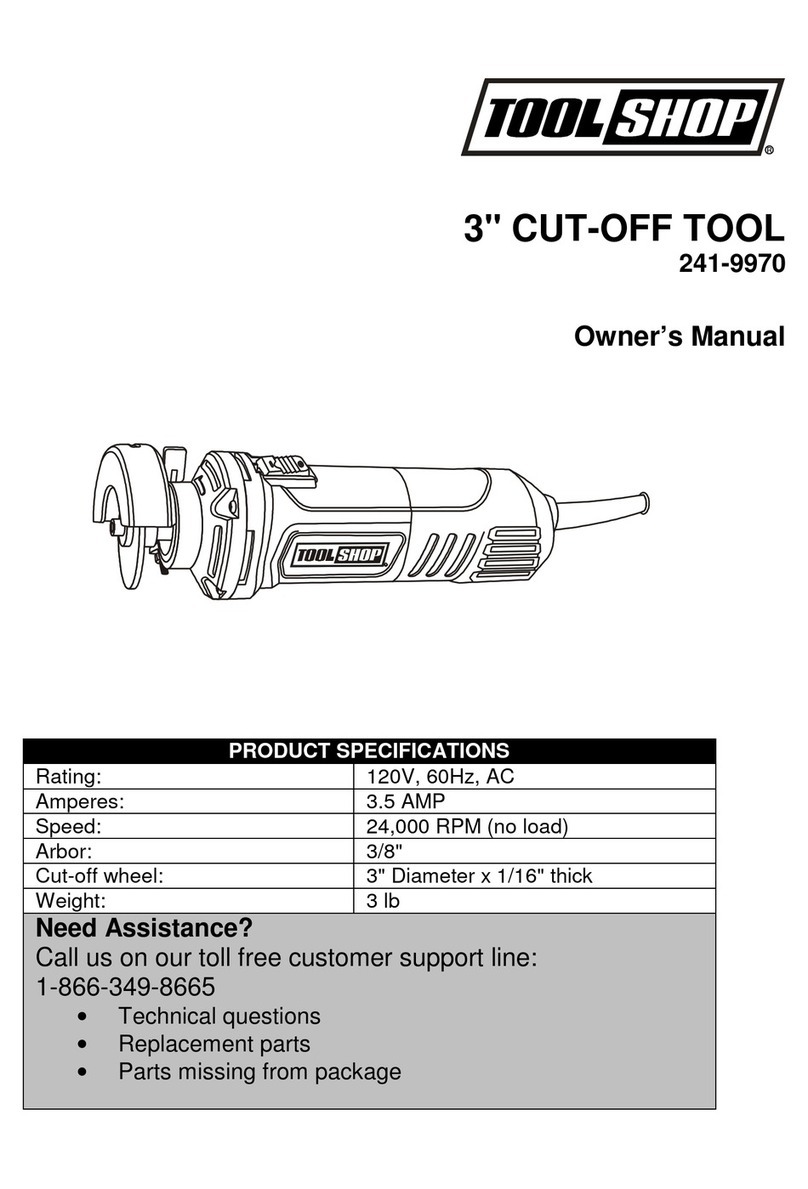
Toolshop
Toolshop 241-9970 User manual
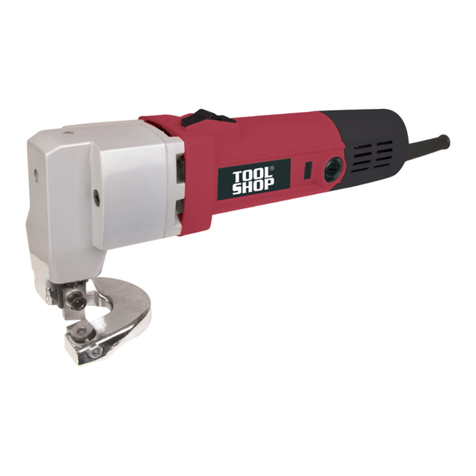
Toolshop
Toolshop 241-9895 User manual
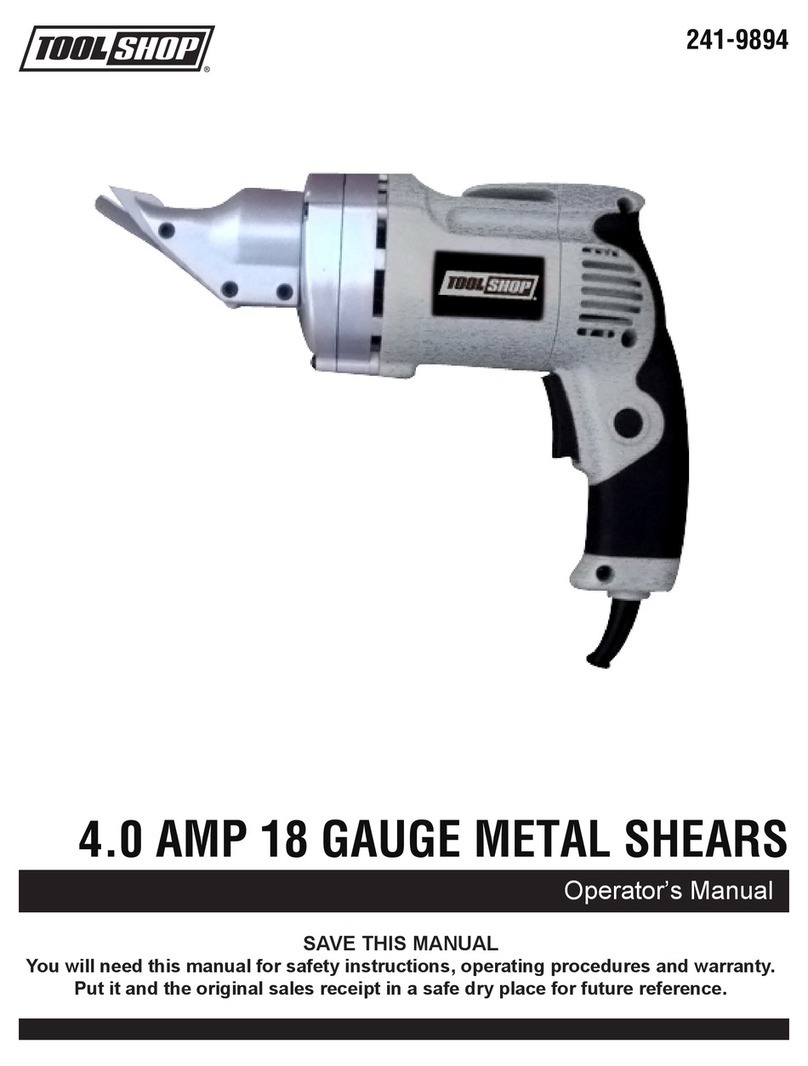
Toolshop
Toolshop 241-9894 User manual
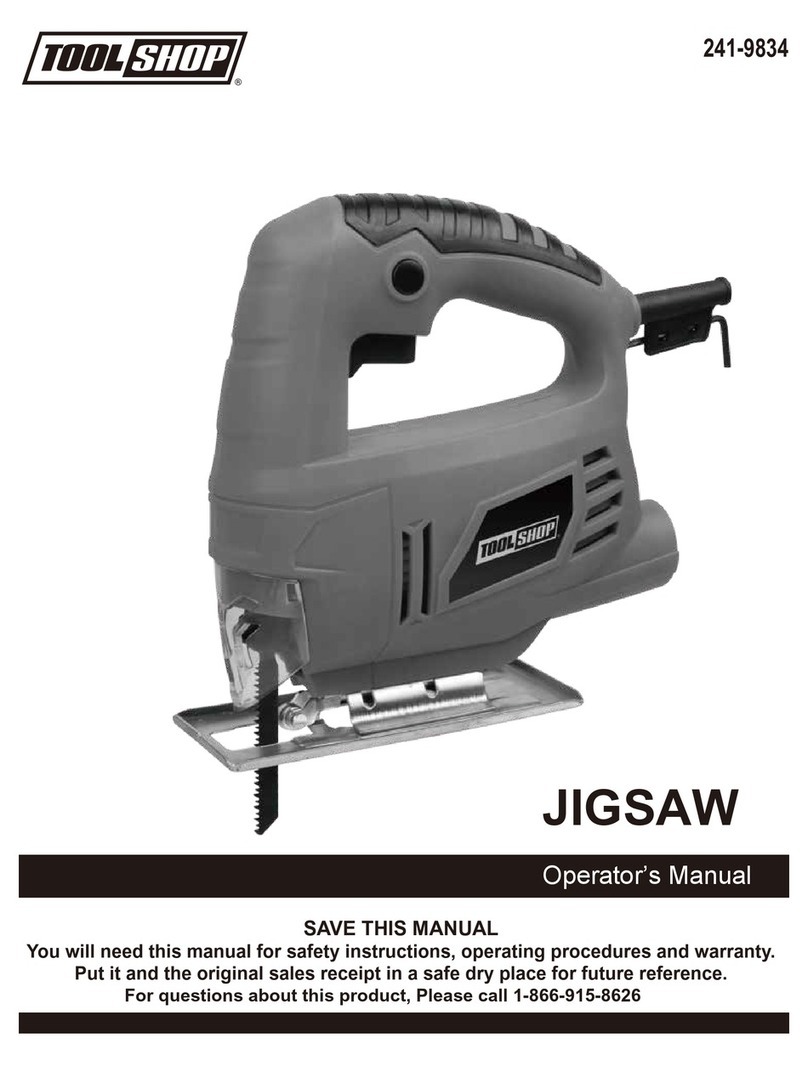
Toolshop
Toolshop 241-9834 User manual

Toolshop
Toolshop 241-9*780 User manual

Toolshop
Toolshop 207-4825 User manual
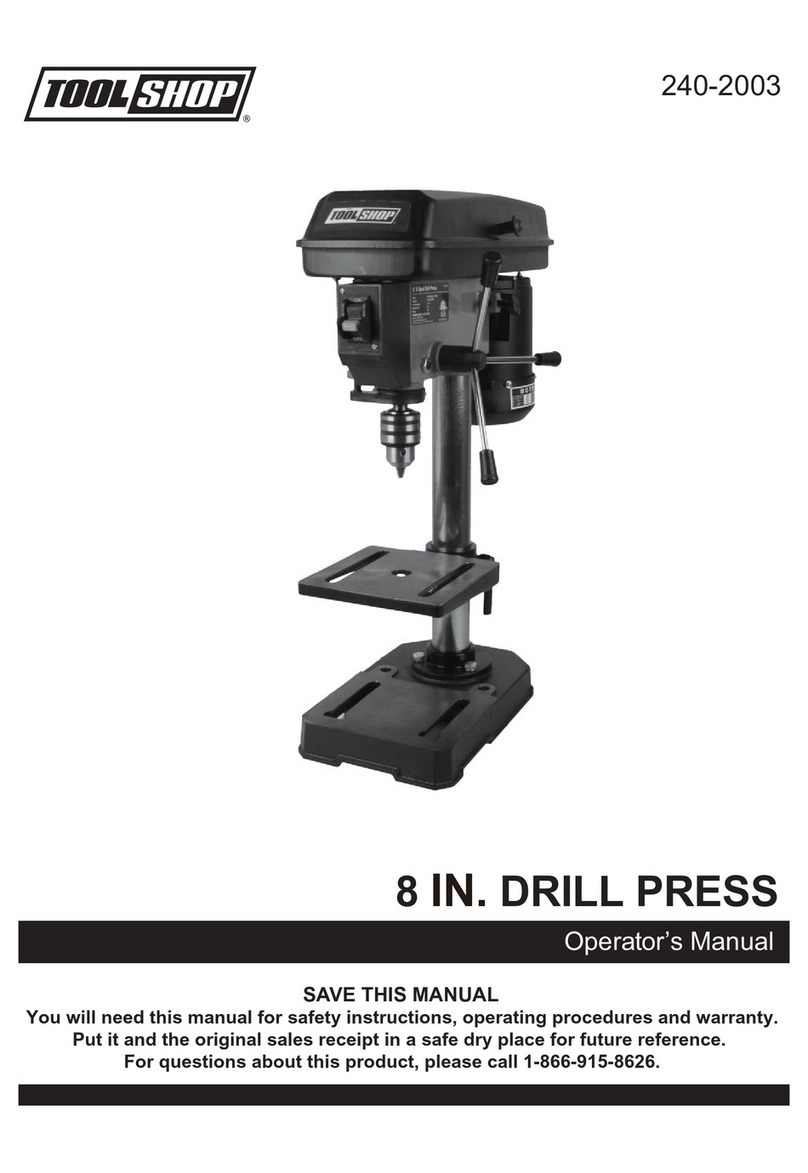
Toolshop
Toolshop 240-2003 User manual

Toolshop
Toolshop 241-9023 User manual
Popular Power Tools manuals by other brands

Master
Master BV 500-13 User and Maintenance Book

Bosch
Bosch GDS Professional 14 Original instructions
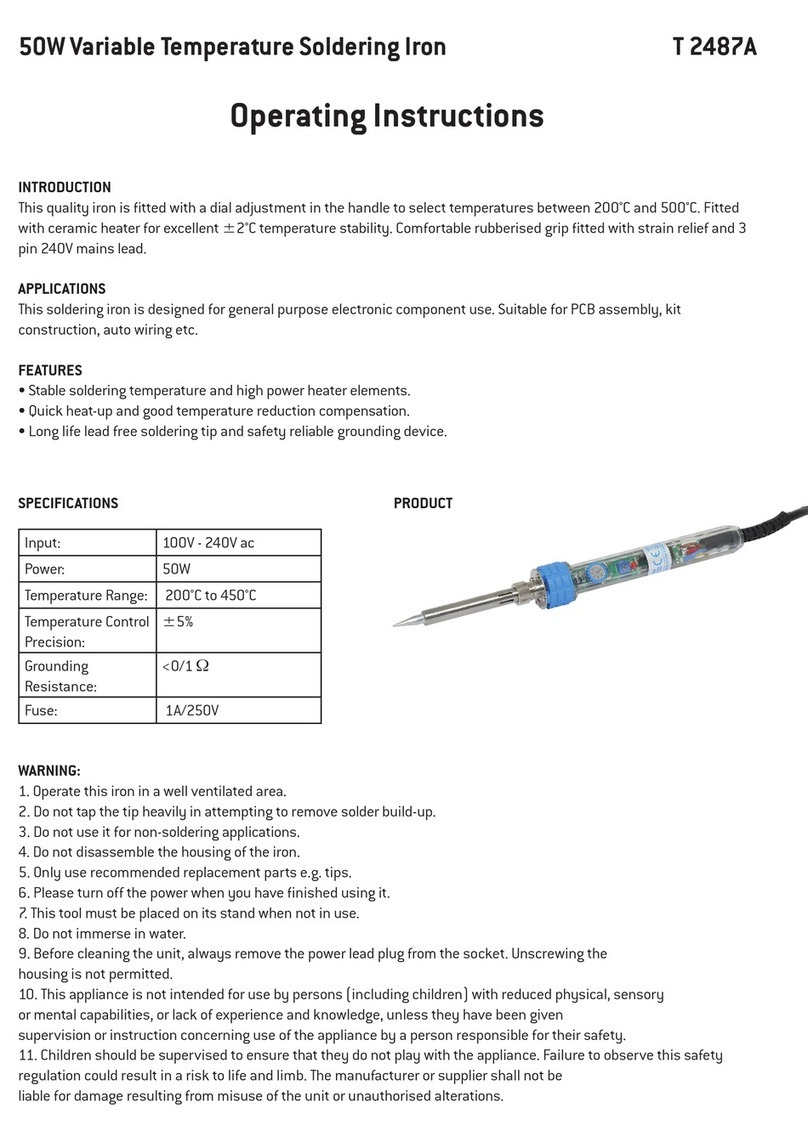
Altronics
Altronics T 2487A operating instructions
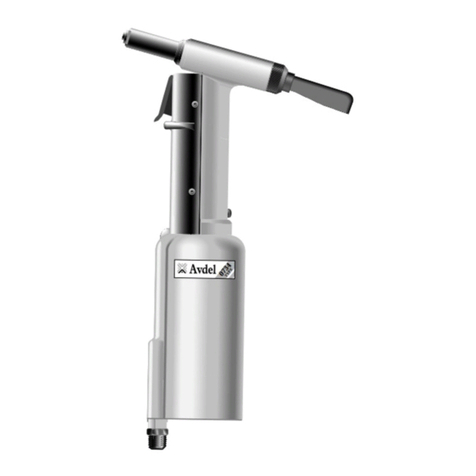
Avdel
Avdel 7340 instruction manual
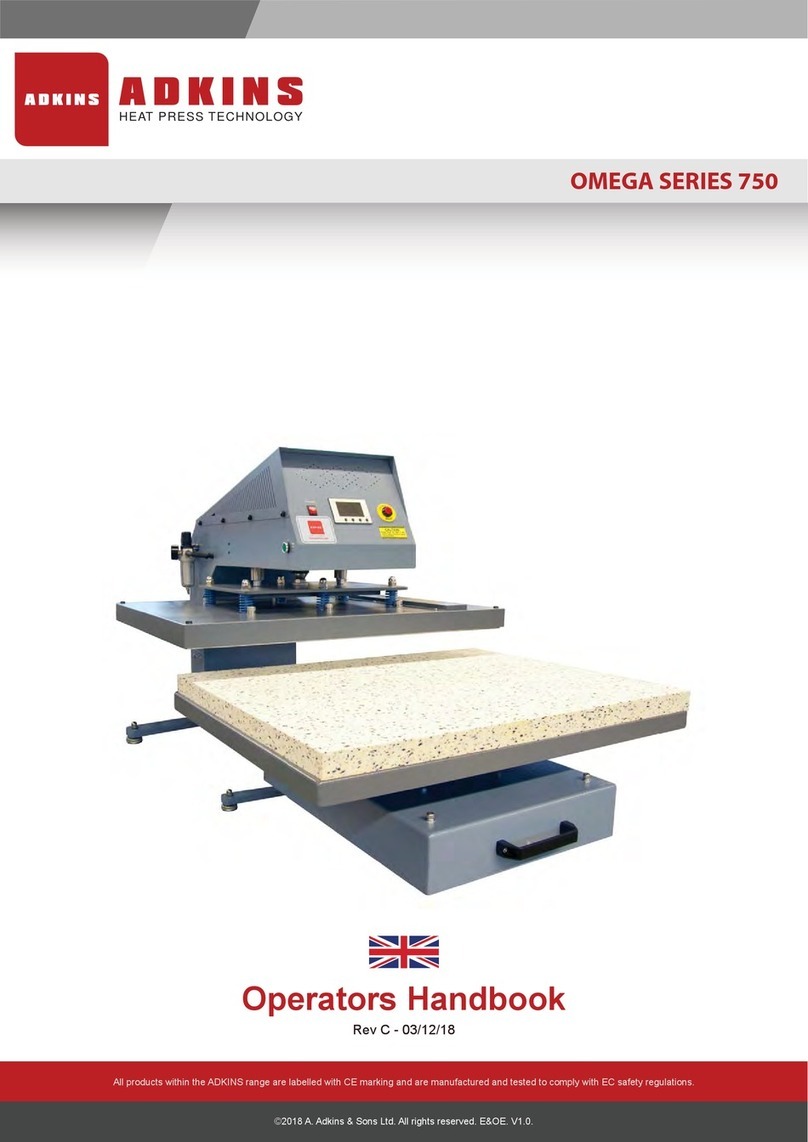
Adkins
Adkins OMEGA 750 Series Operator's handbook
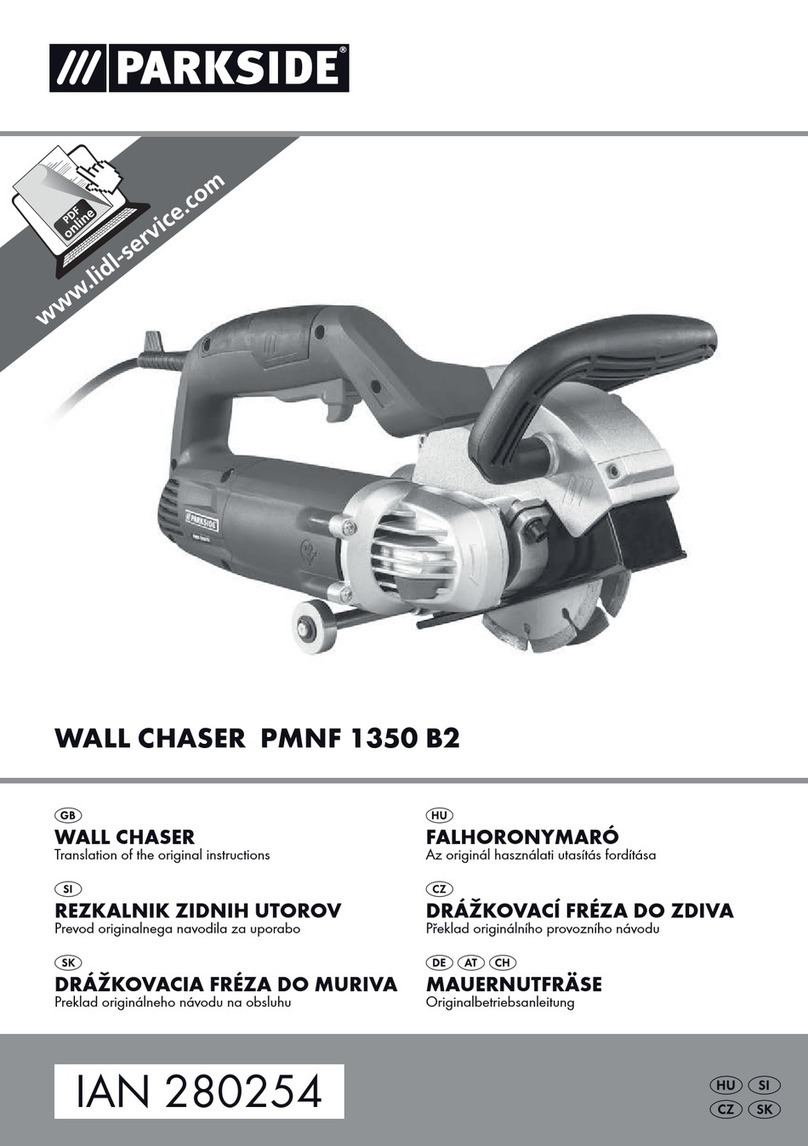
Parkside
Parkside PMNF 1350 B2 Translation of the original instructions
